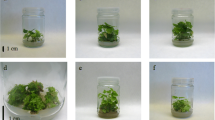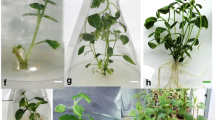Summary
Currently,Cereus peruvianus plants can be rapidly clonedin vitro via adventitious organogenesis using callus cultures; however, somaclonal variation is a problem. A method is described herein using lateral bud explants to produce multiple shoots for clonal propagation. Apical and lateral explants were cultured on MS (Murashige and Skoog, 1962) media with factorial combinations of the auxins indole-3-acetic acid (IAA), 1-naphthaleneacetic acid (NAA), and cytokinins 6-ben-zyladenine (BA) and N-(2-furanyl-methyl)-1-purine-6 amine (kinetin) at the concentrations 0.0, 0.01, 0.1, 1.0 mg“l−1. Positive results were obtained from the lateral explants in all conditions tested, but apical explants did not respond toin vitro multiplication ofC. peruvianus cactus at all growth regulator combinations tested. Formation of axillary shoots inC. peruvianus seems most frequent in medium containing BA at 1.0 mg·l−1 (4.44 μM) and IAA or NAA at 1.0 mg·l−1 (5.71 μM or 5.37 μM respectively), but the frequency of shoot formation in the BA or kinetin and NAA or IAA combinations indicated that any of the combinations tested can be used for multiplication ofC. peruvianus plants regenerated from callus tissue culture. Root formation occurred in all (100%) of the cactus shoots after 9 wk in the same culture medium. All the cacti that developed at the different auxin and cytokin combinations continued growth after transfer to a potting mix of red earth (Paleudult) and ground river sand (1∶1).
Similar content being viewed by others
References
Alvarez, M.; Costa, S. C.; Utumi, H., et al. The anionic glycan from the cactusCereus peruvianus—structural features and potential uses. Appl. Biochem. Biotechnol. 34:283–295; 1992.
Clayton, P. W. Micropropagation as a means of conservation and commercialization of members of the subtribe Cactinae (Cactaceae). Las Cruces: New Mexico State Univ.; 1987. MS Thesis.
Clayton, P. W.; Hubstenberger, J. F.; Phillips, G. C. Micropropagation of members of the Cactaceae subtribe Cactinae. J. Am. Hort. Sci. 115:337–343; 1990.
Dabekaussen, M. A. A.; Pierik, R. L. M.; van der Laken, J. D., et al. Factors affecting areole activation in vitro in the cactusSulcorebutia alba Rausch. Sci. Hortic. 46:283–294; 1991.
Escobar, H. A.; Villalobos, V. M.; Villegas, A.Opuntia micropropagation by axillary proliferation. Plant Cell Tissue Organ Cult. 7:269–277; 1986.
Gamborg, O. L.; Miller, R. A.; Ojima, K. Nutrient requirements of suspension cultures of soybean root cells. Exp. Cell Res. 50: 151–158; 1968.
Hu, C. Y.; Wang, P. J. Meristem shoot tip, and bud culture. In: Evans, D. A.; Sharp, W. R.; Ammirato, P. V., et al., eds. Handbook of plant cell culture. Vol. 1. New York: Macmillan Publishing Co.; 1983:177–277.
Karp, A.; Bright, S. W. J. On the causes and origins of somaclonal variation. Oxford surveys of plant molecular and cell biology. Oxford, England: Oxford University Press; 1985:199–243.
Larkin, P.; Scrowcroft, W. R. Somaclonal variation: a novel source of variability from cell cultures for plant improvement. Theor. Appl. Genet. 60:197–214; 1981.
Machado, M. F. P. S.; Prioli, A. J.; Mangolin, C. A. Malate dehydrogenase (MDH; EC 1.1.1.37) isozymes in tissue and callus cultures ofCereus peruvianus (Cactaceae). Biochem. Genet. 31:167–172; 1993.
Mangolin, C. A.; Prioli, A. J.; Machado, M. F. P. S. Isozyme patterns in callus cultures and in plants regenerated from calli ofCereus peruvianus (Cactaceae). Biochem. Genet. 32:237–247; 1994.
Martínez-Vázquez, O.; Rubluo, A. In vitro mass propagation of near-extinctMammillaria san-angelensis Sánches-Mejorada. J. Hortic. Sci. 64:99–105; 1989.
Mauseth, J. D. Cytokinin and gibberellic acid induced effects on the structure and metabolism of shoot apical meristems inOpuntia polyacantha (Cactaceae). Am. J. Bot. 63:1295–1301; 1976.
Mauseth, J. D. A new method for propagation of cacti: sterile culture of axillary buds. Cactus Succulent J. 51:186–187; 1979.
Mauseth, J. D.; Halperin, W. Hormonal control of organogenesis inOpuntia polyacantha (Cactaceae). Am. J. Bot. 62:869–877; 1975.
Meins, F., Jr. Determination and morphogenetic competence in plant tissue culture. In: Yeoman, M. M., ed. Plant cell culture technology, Oxford, England: Blackwell Scientific Publications; 1986:7–24.
Murashige, T. Plant propagation through tissue cultures. Annu. Rev. Plant Physiol. 25:135–166; 1974.
Murashige, T.; Skoog, F. A. A revised medium for rapid growth and bioassays with tobacco tissue culture. Physiol. Plant. 15:473–497; 1962.
Oliveira, S. A. Cultura de tecidos e regeneração de plantas deCereus peruvianus (Cactaceae). Parana, Brazil: State University of Maringa; 1993. Ms. Thesis. 1–99.
Oliveira, S. A.; Machado, M. F. P. S.; Prioli, A. J., et al. In vitro propagation ofCereus peruvianus Mill. (Cactaceae). In Vitro Cell Dev. Biol. 31:47–50; 1995.
Prioli, A. J.; Mangolin, C. A.; Oliveira, S. A., et al. Isozymes as markers of the effect of growth regulator combinations on callus tissues from long-term cultures ofCereus peruvianus (Cactaceae). Braz. J. Genet. 18:105–109; 1995.
Scheinvar, R. L. Cactáceas. Monography. México DF: Universidad Nacional Autónoma de México, Departamento de Botánica; 1985:1–209.
Starling, R. J. In vitro propagation ofLeuchtenbergia principis. Cactus Succulent J. 57:114–115; 1985.
Turbak, A. F. Cellulose. In: Kirk-Othmer, E., ed. Encyclopedia of chemical technology. New York: Wiley-Interscience; 1979:99–119.
Vyskot, B.; Jára, Z. Clonal propagation of cacti through axillary buds in vitro. J. Hortic. Sci. 59:449–452; 1984.
Author information
Authors and Affiliations
Rights and permissions
About this article
Cite this article
Machado, M.d.F.P.S., Prioli, J. Micropropagation ofCereus peruvianus mill. (cactaceae) by areole activation. In Vitro Cell Dev Biol - Plant 32, 199–203 (1996). https://doi.org/10.1007/BF02822766
Received:
Accepted:
Issue Date:
DOI: https://doi.org/10.1007/BF02822766




